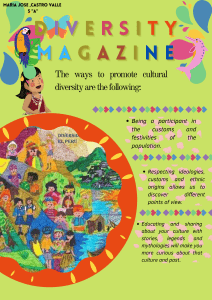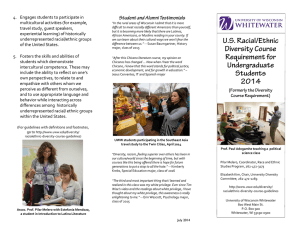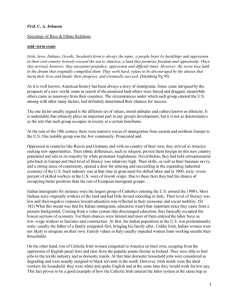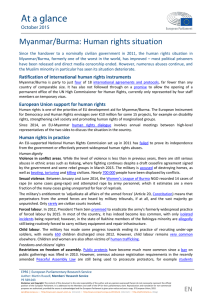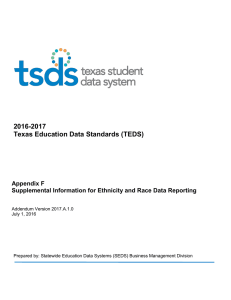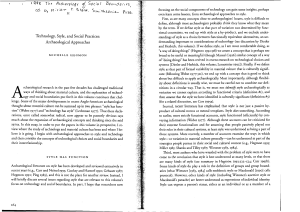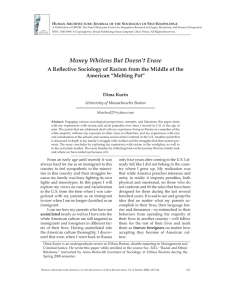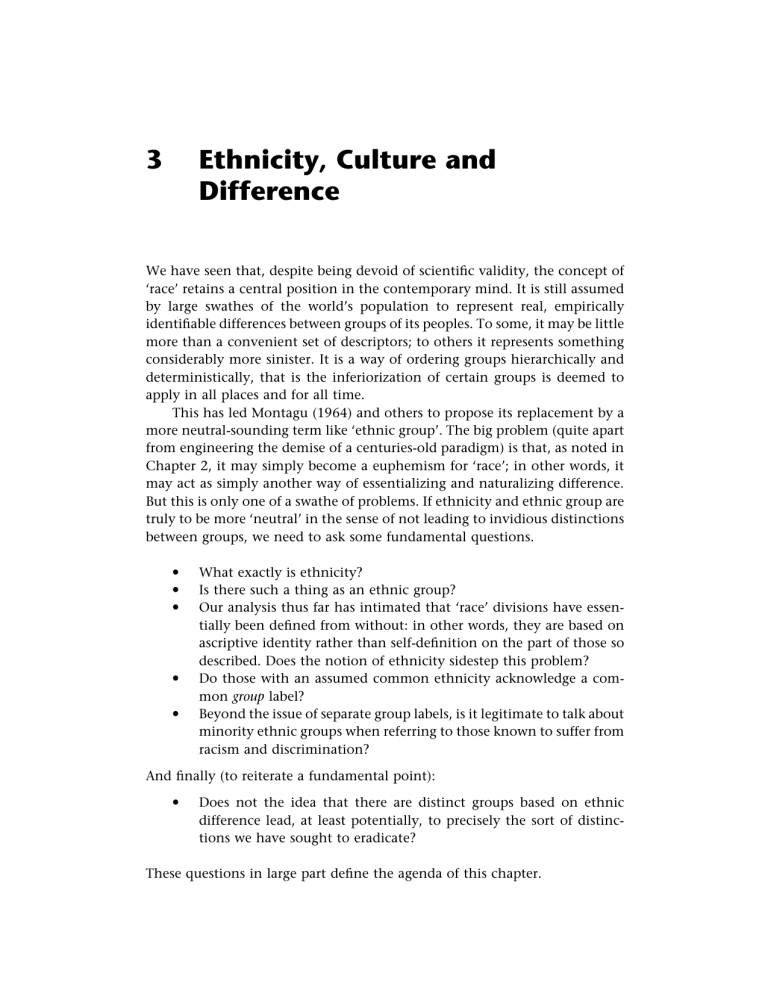
3 Ethnicity, Culture and Difference We have seen that, despite being devoid of scientific validity, the concept of ‘race’ retains a central position in the contemporary mind. It is still assumed by large swathes of the world’s population to represent real, empirically identifiable differences between groups of its peoples. To some, it may be little more than a convenient set of descriptors; to others it represents something considerably more sinister. It is a way of ordering groups hierarchically and deterministically, that is the inferiorization of certain groups is deemed to apply in all places and for all time. This has led Montagu (1964) and others to propose its replacement by a more neutral-sounding term like ‘ethnic group’. The big problem (quite apart from engineering the demise of a centuries-old paradigm) is that, as noted in Chapter 2, it may simply become a euphemism for ‘race’; in other words, it may act as simply another way of essentializing and naturalizing difference. But this is only one of a swathe of problems. If ethnicity and ethnic group are truly to be more ‘neutral’ in the sense of not leading to invidious distinctions between groups, we need to ask some fundamental questions. * * * * * What exactly is ethnicity? Is there such a thing as an ethnic group? Our analysis thus far has intimated that ‘race’ divisions have essentially been defined from without: in other words, they are based on ascriptive identity rather than self-definition on the part of those so described. Does the notion of ethnicity sidestep this problem? Do those with an assumed common ethnicity acknowledge a common group label? Beyond the issue of separate group labels, is it legitimate to talk about minority ethnic groups when referring to those known to suffer from racism and discrimination? And finally (to reiterate a fundamental point): * Does not the idea that there are distinct groups based on ethnic difference lead, at least potentially, to precisely the sort of distinctions we have sought to eradicate? These questions in large part define the agenda of this chapter. 28 ‘RACE’, ETHNICITY AND DIFFERENCE What is ethnicity? As with ‘race’, the precise nature of ethnicity is highly contested terrain. In this case, however, the debate surrounds competing theories rather than its fundamental ontological status. But, as with ‘race’, the term tends in practice to be deployed extremely loosely, to imply commonalities of language, religion, identity, national origins and/or even skin colour. Bulmer (1986), along with many sociologists and anthropologists, sees the core element as to do with ‘memories of a shared past’, a sort of collective memory of a people. But there are a number of problems here. Are we talking about a form of primordialism based on recognized ‘facts’ of history (assuming these can be determined and are part of the sedimented knowledge of a people over generations) or, rather, different understandings of history? Are these simply ‘imagined communities’ in the sense in which Benedict Anderson (1993) used the term? What role might ethnic mobilization play here? Recalling the Balkan wars of the 1990s, we heard a great deal in the media and political discourse about Serb, Croat and Bosnian identities. In cases where (say) Serb and Croat had lived happily side by side for decades and even intermarried, suddenly there were social divisions of catastrophic proportions. One plausible interpretation for this turn of events is that their separateness was to a point ‘manufactured’ by leaders bent on deploying ethnic mobilization to achieve wider political ends. What is incontestible is that they were seen to draw on fragments of history (a partial history): memories of (say) a ‘greater Serbia’ fusing a reconstructed and bolstered sense of ethnicity with nationalism. As is known all too well, ‘ethnic cleansing’, a terrible euphemism for genocide, was the result. It might be argued that ethnicity, rather than being essentially primordial, has more to do with situation or context. This situational interpretation suggests that we have highly complex and multi-dimensional ethnocultural identities. The essential point is that different aspects of our identity (not necessarily rooted in heritage) emerge in different social contexts. A simple example, often remarked upon in the literature, is the case of South Asian youth. At home they may speak Urdu, Hindi or Punjabi and dress quite happily in accordance with their family’s wishes. In the public sphere, however, they may have carved out a rather different persona, with AngloAsian or African-American-Asian overtones. Black street styles are common in most towns and cities in Europe and the US, irrespective of an individual’s family origins or heritage. In so far as these appear to presage wider alliances amongst minority groups, they may be seen as threatening. In the course of research in Bradford in northern England in the 1990s, local council officials spoke to me in rather nervous tones about the increasing popularity of gangsta rap amongst the ETHNICITY, CULTURE AND DIFFERENCE 29 city’s Muslim youth. This was seen as a socially cancerous process which threatened to envelop swathes of disaffected young people irrespective of putative ethnic background. In the sphere of popular music more generally, prominent UK-based bands such as Apache Indian and Asian Dub Foundation are important for having defined a public cultural space for contemporary Asian youth. The key question, however, is whether this represents ethnicity, or merely lifestyle or a sort of off-the-peg identity. It is perhaps not ethnicity in the classic sense as applied by key thinkers such as Barth (1969), for whom ethnicity is about the processes surrounding boundary maintenance. But it is arguably a major component of contemporary cultural formations and, potentially at least, about future group formations. As we shall see later, it is associated with who one is and, crucially, with whom one identifies and socializes. Current debates as to whether the celebrated (white) soccer player David Beckham is really ‘black’ are a case in point. Those who make this claim, including many within the black community, do so on the basis of his adopted persona and prior associational patterns whilst growing up in London. The argument is therefore that, irrespective of his evident phenotypical traits, he is nevertheless culturally (and ethnically?) black. This raises the rather obvious point that there are certain aspects of who we are which we cannot change. One example, drawn from Malik (1996b: 9) will serve here. There is a scene in Woody Allen’s film Bananas, in which our luckless hero, played by Allen, bemoans the fact that he dropped out of college. ‘What would you have been if you had finished school’, someone asks him. ‘I don’t know’, sighs Allen. ‘I was in the black studies programme. By now I could have been black.’ The point here is that who we are is partly a product of our heritage, who we think we are and also how others perceive us. Boundaries are arguably the outcome of these negotiated constructs. But, the bottom line is that although a white person can associate with those who are black, it is the immutable fact of skin pigmentation which above all else determines treatment on an individual basis. Only those who possess, or who appear to possess, certain phenotypical characteristics experience the full force of racism. A further interpretation sees ethnicity as constantly changing, not permanently anchored in history, either ‘real’ or imagined. As with the situational variant, it arises from social interactions of various kinds, and draws inspiration from global, national and local contexts. This is the essence of cultural hybridity and of diasporic identities which are seen by many as integral to contemporary transnational communities (Cohen 1994, 1997; Back 1996). The core argument is that major political fissures across the globe, 30 ‘RACE’, ETHNICITY AND DIFFERENCE especially since the late 1980s, have generated not only a very different mapping of nations and ethno-national groups but also an ever-increasing flow of migrants with meaningful roots in a number of countries and even continents. What we have, therefore, is a complex fusion of language, culture, religion and attachment to place. Some would see ethnicity as layered. As Fenton (1999) argues, some aspects are global. We all belong to global communities along, say, linguistic or religious lines; for example, the English- or French-speaking world, world Jewry or the followers of Islam. The difference between these examples is that the historical forces which generated linguistic hegemony were not necessarily conducive to the development of forms of collective identification on ethnocultural lines; indeed, they were always rather more likely to have the opposite effect. Recent conflict in the Middle East, however, has demonstrated in the clearest possible terms that the same is not true for Islam. Islamic identity clearly transcends national borders, and supersedes other forms of self-identification such as nation or region. Perhaps the best way of viewing ethnicity is as something which is multidimensional and stratified. The borders between those of different putative ethnicity, in so far as they can be discerned, are subject to negotiation and renegotiation and, as a result, constantly shifting. Our examples drawn from contemporary culture and political economy show how other global or transnational factors are part of an ‘ethnicity-making’ process. The central feature of nationalist agendas is an attempt to undermine forms of ethnic identity which acknowledge these wider forces. In the UK, the clearest example of these came from Norman (later Lord) Tebbit, ex-cabinet minister and Chairman of the Conservative Party in Margaret Thatcher’s administrations in the 1980s. His infamous ‘cricket test’, in which migrants to the UK of, say, Indian or Pakistani origin were expected to support the English cricket team rather than that from their homeland was part of a crude strategy to coerce people into adhering to a narrow Anglocentric identity. One can clearly be both Asian and British, and many other things as well. Transnational migrants, and their descendants, will in most cases have a complex sense of ‘home’. Parminder Bhachu’s Twice Migrants (1985), those who (largely at the behest of colonial administrations) migrated to East Africa from the Indian subcontinent before settling in Britain, normally feel strong affinities with at least two, in many cases three, countries and continents. Seen in these terms it is obvious that ethnicity is not amenable to simple empirical investigation and measurement. This is not, however, to endorse the anti-essentialist or poststructuralist positions fully. To say something is complex and shifting does not imply rejection of the idea that there are ‘real’, discernible groups (a function of both ascriptive and self identity). We shall see shortly how sociologists, social anthropologists and policy-makers have ETHNICITY, CULTURE AND DIFFERENCE 31 attempted to research ethnicity empirically. First, however, we turn to the thorny question of ethnic group formation. What is an ethnic group, and how is it formed? Much of this discussion about the nature of ethnicity concerned the making, and re-making, of bonds between people. There are a series of key questions here. What are the motors behind the making of an ethnic group? What binds these individuals together? Are there occasions when the term ‘ethnic group’ merely represents a loose collectivity of people associated with a common (socially constructed) label? Defining ethnicity in the way we have suggests that it would be extremely difficult to define distinct ‘ethnic groups’. If ethnicity has primordial elements but is constantly changing, situational and/or multi-layered then how might ‘groups’ emerge (as distinct from loose collectivities)? The fact remains that ‘groups’ are made both from without and from within. Often they are the product of centuries-old conflicts and alliances, or based on common claims on territory. Where nations are the product of a fusion of groups with quite different cultural traditions, language and even religion, wars of liberation or regime change may lead to the emergence (or reemergence) of a myriad of groups with quite separate agendas. The recent war in Afghanistan, for example, revealed a complex system of ‘ethnic groups’ occupying various regions of the country: primarily the Uzbeks, Tajiks and Pashtuns. Although formally designated as an ‘alliance’ (as indeed they were in the narrow sense of opposing the Taliban), they were always likely to take this opportunity to press individual claims for recognition (and representation in any new government). The fall of the Soviet Union was accompanied by intense conflict as groups fought to gain independence and control of what they saw as occupied territory. In the US, migrant groups such as Mexicans, Puerto Ricans, Cubans and Chinese would in general define themselves in these ethno-national terms. It is clear, however, that these groups are different in sociological terms from those discussed in the previous paragraph. The question is: in what ways are they different? It is clear that what gives them their group status is not a collective territorial claim. We need to have some way of explaining how ethnic groups are formed and how group labels appear. It will become evident that in many cases the latter are the result of a complex dialectical process with both external and internal influences. Particularly problematic is a determination of the empirical content to which a label refers, especially when the latter may be the subject of considerable contestation by those who ostensibly share the same label. Underlying these difficulties is a historical process of ethnicity-making. 32 ‘RACE’, ETHNICITY AND DIFFERENCE A useful way of getting to grips with the major dimensions of this is to use Eriksen’s (1993) schema, as modified by Fenton (1999: 32–3). (The astute reader will note that this tends to simplify and ‘freeze’ groups in ways that contradict some of our prior arguments: we shall return to this issue later.) Urban minorities – examples here would be the migrant worker populations in American and European cities and in the economies of newly industrializing societies (for example Indonesian workers in Malaysia) and trader minorities (such as Chinese merchants in the Caribbean). Proto-nations or ethno-national groups – people who have and make a claim to be nations, and thus make a claim to some form of self-governance while being incorporated within a larger state. The obvious examples here would be the Québécois in Canada, Kurds in (and around) Turkey and the Basques (or Catalans) in Spain. Ethnic groups in plural societies – these are the descendants of populations who have typically migrated as coerced, voluntary or semi-voluntary workers, and have come to form distinctive, and sometimes large, minorities in the new context (for example the Chinese in Malaya). It is noted that they rarely make a claim for separate ethno-national status but form a distinct segment of a nation state system. Indigenous minorities – peoples dispossessed by colonial settlement. Obvious examples would be the Aboriginal peoples of Australia, the Maoris of New Zealand and the island peoples of the Pacific, such as the Hawaiians. In addition, there are the native American peoples of North, Central and South America. Post-slavery minorities – the ‘black’ African descendants of people formerly enslaved in the New World, of which black and African Americans are the obvious example. In this final case, Fenton rightly argues that the picture has been considerably complicated by intermarriage, with ‘mulatto’ and ‘mixed race’ (sic) groups often forming partly distinct populations. This provides a clear hint, if one were needed, that group formation represents a constant process of evolutionary change. Fenton argues that an exploration of the social, cultural and political trajectories of these groups provides an insight into the significance of ethnicity in the modern world. This is absolutely correct. But an overriding focus on the history of particular ‘ethnic groups’ has its dangers, in particular ETHNICITY, CULTURE AND DIFFERENCE 33 the (at times) highly partial histories which form the core of social anthropological ‘knowledge’. The dangers of the ‘ethnicity paradigm’ Because of this, some words of caution need to be added at this point. As was argued by Blauner (1972), and subsequently reinforced by Jenkins (1986a, 1987), much of the older social anthropological literature has been problematic in the sense of lacking a nuanced approach to power and stratification. This was partly due to a tendency to look at the experiences of single putative groups in isolation, partly a lack of reflection on the precise significance of external structural factors such as racism and discrimination. Particular problems arose because of the dominant focus on ‘culture contact’, ‘boundary maintenance’ and inter-ethnic rivalry. The key points may be summarized quite simply: * * * Too much emphasis placed on internal strategies, hopes and aspirations: too little on the external social context. In more theoretical terms, social agency tended to take precedence over structural forces, that is the forces of social regulation. We shall see many examples of this in the area of housing and residential patterns in particular (see Chapter 5). ‘Race’/ethnicity also tended to take precedence over class and social stratification. This was even a problem with analyses which deployed what were, in other respects, quite sophisticated models based on plural society theory (see Kuper 1974). As noted earlier, critical realism has performed a highly useful role in warning sociologists of the dangers of slipping into monocausal explanations (Carter 2000). If the analytical focus of a study is ethnicity and ethnic group formation, it is all too easy to suggest, if only by implication, that these factors (and not others) are the principal determinants of substantive variations in material outcomes. In general, there was also too much emphasis on ‘tradition’ and on ‘traditional customs’ clashing with the modern (assumed superior?) world. One outcome was the suggestion that young people from migrant households faced a particular crisis. They were viewed as being caught ‘between two cultures’, the traditional world of home and the Western (that is, ‘modern’) world beyond its confines. One prominent text published in the late 1970s (Watson 1977) adopted this notion as its title. It is essentially an anthology of social anthropological studies focusing on different migrant groups. It contains an interesting example of the traditional–modern (‘first 34 ‘RACE’, ETHNICITY AND DIFFERENCE * world’) dualism – in Nancy Foner’s research on female Caribbean migrants to the UK. The latter are seen as having gained extensive new freedoms simply by virtue of their move to the metropolis, most notably in the area of consumption, for example car ownership, and expansion of their social world via pubs, restaurants and the like. (A further important problem, noted by Carby 1982a, stems from the notion of tradition. Much of what passes as tradition is in fact little more than the end product of earlier struggles: in many cases value systems imposed by imperialist and colonial powers. This should serve to remind us of the constant volatility of sociocultural forms, and formations.) Ethnic essentialism, static values and the presumed uniqueness of the group constitute a final series of problems. One often gets a sense that the group concerned is not only a uniform whole but is also frozen in aspic (for all time). Difference is prioritized over diversity, and the uniqueness of a group’s experiences is accentuated (or even fetishized). Although this has the advantage of highlighting key variations in cultural forms and practices, it also has the effect of concealing important commonalities of experience. In other words, the subjection of all minority groups (and, in particular, the poorer members thereof) to various forms of racism and discrimination often recedes into the background. The effect of this prioritization of agency over structural constraint (whilst a useful antidote to accounts which take the diametrically opposing, similarly simplistic view) is a neglect of one of the key dimensions of everyday experience. A fully rounded account must reflect the complex dialectical relationship between various forms and levels of agency and a myriad of ‘structures’/forces of regulation. Naming difference: problems of nomenclature Despite difficulties with the definition of ethnic groups arising from their formation and re-formation, those wishing to make sense of contemporary social relationships and structures of inequality have to resort to some form of descriptive categories. The problem is that there are many different, and often incompatible, ways of ‘slicing’ social reality, and each is likely to be less than ideal. Whereas some ethnic labels emerge through a process of self-definition, untainted by explicit external forces, most, as implied by the earlier discussion of group formation, are not. The issue of nomenclature is important for two main reasons. First, those who generate the emergent categories are invariably members of superordinate groups (which, of course, also includes ETHNICITY, CULTURE AND DIFFERENCE 35 academia). Second, and partly as a result of this, application of the labels may act to weaken further the position of subordinate groups. For these reasons, both the process of categorization and the labels themselves should be subjected to scrutiny. This applies even where groups appear on the surface to accept the conventional descriptors. Explicit ‘race’ categories such as negro or negroid have long been assigned to history, at least in social science and political discourse. With wellnigh universal agreement, these discredited notions have been superseded by the generic term ‘black’. This was no accident, and certainly was not the result of a spontaneous change of heart by politicians, policy-makers or statisticians. It was a response to civil rights activity, and especially the emergence of Black Power in the US. Thus, social agency on the part of subordinated peoples was the key to the change. But this new focus on a particular phenotypical feature, a notional skin colour, was accompanied by a further unfortunate tendency. This was the discourse of colour. North Americans still talk of ‘persons of color’ to refer to those who are not ‘white’; in other words ‘the other’. In apartheid South Africa it was used to refer to those, largely of South Asian or ‘mixed’ origin, who did not fit the polar categories of white and black. This implicit colour banding, which represents an atavistic tendency in the sense of mirroring early theories of ‘race’ hierarchies, also applies in certain official statistics in Britain, as will be seen below. The term is certainly seen as offensive by those it claims to represent. If the generic term ‘coloured’ is rejected, then what are the alternatives (from the perspective of those wishing to develop an emancipatory, or at least non-oppressive, discourse)? An understandable desire to avoid any reference to ‘race’, however oblique, led in Europe to the notion of ‘ethnic minorities’. There were two problems with this. One, it was seen by many as simply a euphemism for ‘races’, despite the absence of any explicit reference to this concept. Second, it was increasingly seen as extremely insulting to those so described. It did, after all, appear to suggest, as we saw in Chapter 1, that only ‘minorities’ have an ethnicity. No one referred to the existence of ethnic majorities, or the ethnic majority. For this reason, sociologists tended to replace this with the admittedly similar-sounding ‘minority ethnic groups’. It is worth repeating the point from the opening chapter, that this immediately suggests both that there are indeed majority groups which also possess an ethnicity and that the focal point is on numerical size (notwithstanding the concerns expressed in the Parekh Report – Runnymede Trust 2000: xxiii). In the UK the term ‘West Indian’, normally applied by social scientists and policy-makers up to the early 1980s to refer to migrants from the Caribbean of African origin, was replaced first by Afro-Caribbean and then by Black-Caribbean or African-Caribbean. This is an interesting case for two reasons. One is that rejection of ‘West Indian’ emanated from a desire to rid the language of a term with colonial roots and replace it with one (African- 36 ‘RACE’, ETHNICITY AND DIFFERENCE Caribbean) that reflects both contemporary geography and historical reality. The second point reminds us of the ‘durability’ of labels. Many to whom the new term refers still adopt the old label. It also lives on in public consciousness in obvious ways, most notably in sport, for example through the cricket team from the region: West Indies. This illustrates both the socially constructed origin of ethnic labels, and their continually contested nature (from both within and without). Sometimes they may essentially represent convenient collectivities of individuals with certain commonalities of geography or language; on other occasions, they may describe those who can be characterized more readily as representing a group, or group-like, entity. Are ethnicity and ethnic group measurable? This raises one of the key questions for the current volume. Is it possible to identify the essence of ethnicity empirically and, more to the point, can we then develop a robust measure of ethnic group membership? Our earlier discussion of the nature of both concepts implies that this is not an easy task. But to do so is a prerequisite for any analysis (the current volume included) aiming to assess levels of inequality between various population groups, and then identify the underlying causes (remembering that ethnicity is only one of a number of different factors likely a priori to contribute to observed differentials). As the core requirement is large-scale data, the obvious focal point is national census data. The first thing to note here is that not all states undertake censuses, and of those that do not all ask a question on ethnic origin or group. In mainland Europe, for example, the Netherlands fall into the former group, relying instead on national registration data supplemented by more locally generated data. The French government undertakes regular censuses but retains the view that to ask about ethnicity would be to contravene a core tenet of the constitution. Going back to the formation of the Republic, there has been a more or less consistent assumption that all citizens of France, irrespective of colour, ethnicity, religion and national origins, have equal rights de facto as well as de iure. To suggest otherwise would be to imply the failure of successive governments to achieve the freedom, equality and fraternity at the core of republican philosophy. However, increasing evidence of inequalities and the growth of the Front Nationale, a political party promoting an explicitly anti-immigrant and anti-minority agenda, has drawn attention to the need to address issues of ‘race’. European legislation is also now forcing a change of heart. The US census asks about ethnic origin, but the problem here is that the Bureau of the Census has been pressured by increasingly vocal minorities to ETHNICITY, CULTURE AND DIFFERENCE 37 respect the distinctness of more and more ‘ethnicities’. The upshot is that it has become ever more difficult to make meaningful comparisons, especially over successive censuses. In Canada, there is also a question about ancestry. What this does, in theory at least, is provide a much clearer picture of the primordial dimensions of ethnic identity. For this reason, it was considered by the Office for National Statistics in the run-up to the 2001 Census in Britain. It was ultimately rejected on the grounds that this would be too difficult an exercise, and would probably lead to data of questionable quality (because of the twin problems of reliability and validity). In the event, the form contained a modified version of the question from the previous census (1991) supplemented by a new question on religion. The three questions are presented in Figs. 3.1 to 3.3. Fig. 3.1 Question on ‘Ethnic Group’ from the GB Census of Population, 1991. 11 Ethnic group Please tick the appropriate box. If the person is descended from more than one ethnic or racial group, please tick the group to which the person considers he/ she belongs, or tick the ‘Any other ethnic group’ box and describe the person’s ancestry in the space provided. White Black-Caribbean Black-African Black-Other please describe Indian Pakistani Bangladeshi Chinese Any other ethnic group please describe c0 c1 c2 c c c c c c 3 4 5 6 A key question is whether we have a measure that enables us to assess both levels of material inequality between putative ethnic groups and the implications of ethnic diversity. The latter is important not just to sociologists, but also to policy-makers exploring the needs and aspirations of those who wish to define their ethnicity in a particular way. At best, the answer is a highly qualified ‘yes’. The reasons are not hard to discern. As we have said, ethnicity is a highly complex and contested notion. The census is based on a brief self-completion questionnaire, where the only assistance comes via a local enumerator. Categories need to be fairly parsimonious and questions easy to follow. The major problem for the analyst is that the ethnic group question is inevitably Janus-faced (Ratcliffe 2001a). Even a casual glance at the 1991 version illustrates this. Given our earlier discussion about the nature of ethnicity, one thing is clear. Whatever the question does measure, it certainly is not ethnicity. ‘White’ is clearly a pseudo-‘racial’ term based on phenotype, ‘Black- 38 ‘RACE’, ETHNICITY AND DIFFERENCE Fig. 3.2 Question on ‘Ethnic Group’ from the GB Census of Population, 2001. 8 What is your ethnic group? ^ Choose ONE section from A to E, then [ the appropriate box to indicate your cultural background A White c British c Irish c Any other White background, please write in B c c c c Mixed White and Black Caribbean White and Black African White and Asian Any other Mixed background, please write in C c c c Asian or Asian British Indian c Pakistani Bangladeshi Any other Asian background, please write in D Black or Black British c Caribbean c African c Any other Black background, please write in E Chinese or other ethnic group c Chinese c Any other, please write in Caribbean’ also prioritizes phenotype and conflates a variety of island origins and language groups (most obviously Anglophone and Francophone peoples). ‘Indian’, for example, brings together under one label those of many different religious, linguistic and regional backgrounds, including Bhachu’s Twice Migrants (1985) hailing from East Africa. The key points are that assumed skin pigmentation takes priority over self-defined ethnicity, and an undifferentiated ‘we’ is contrasted with a slightly more differentiated ‘other’. The 2001 variant clearly recognizes the need for a more sophisticated listing of groups. But the demand for data comparability over the ten-year ETHNICITY, CULTURE AND DIFFERENCE 39 Fig. 3.3 Question on Religion from the GB Census of Population, 2001. 10 What is your religion? ^ This question is voluntary. ^ [ one box only. c None c Christian (including Church of England, Catholic, Protestant and all other Christian denominations) c Buddhist c Hindu c Jewish c Muslim c Sikh c Any other religion, please write in period reduced the scope for change. Twenty-first-century realities forced the inclusion of a ‘mixed’ section, and the notion of joint identification with Britain on the part of those of minority origin is also acknowledged. The problem is that the focus remains on ascriptive rather than self identity, and although we now have a slightly more nuanced form of categorization, the analyst is unable to distinguish, for example, between those who define themselves as ‘Asian’ and those who opt instead for ‘Asian-British’. There is also a rather unfortunate, albeit unintentional, atavistic allusion to Social Darwinian notions of ‘racial purity’, with the White category followed by the ‘Mixed’ category, divided into ‘White and . . .’, prior to a reference to those who are (purely?) ‘Black’ or ‘Asian’. The religion question may permit a rather more precise fix on ethnic background, but here again there is a totally undifferentiated ‘we’ in the form of ‘Christian’, and a much more detailed listing of the assumed ‘other’. General opposition to the question also led to a remarkably successful Internet campaign encouraging the disaffected to enter ‘Jedi Knight’ in the ‘write in’ section, on the grounds that if sufficient numbers did so this fictitious category would become officially recognized. Despite these quibbles, the measures, taken together, provide what is in pragmatic terms a useful slicing of social reality. The labels they deploy are almost universally accepted, or at least recognized, by those to whom they are intended to refer. It is clear, however, that they are much better as a basis for investigating material inequalities than they are in determining possible ethnicity-specific needs and aspirations. We have looked at these issues in some detail at this juncture because most analyses, and indeed most non-census investigations, tend to use these 40 ‘RACE’, ETHNICITY AND DIFFERENCE or parallel descriptors. One simply has to bear in mind constantly, then, that they do not represent an unambiguous, essential social reality: we are effectively compelled to use them warts and all. Further reading Clearly, the literature on ethnicity, ethnic group formation and ethnic mobilization is vast. The following account must therefore be seen for what it is, namely highly selective and indicative. It divides contributions into classical theorizations, modern reformulations of these debates and, finally, substantive accounts relating to contemporary Britain. In the first category is a book already recommended in the previous chapter. Rex and Mason (1986) contains a series of extremely useful essays by internationally renowned proponents of rational choice theory, plural society theory and sociobiology. The essay by Richard Jenkins also presents a useful antidote to the crude forms of theorization based on, and celebrating, ethnic difference. The Rex and Guibernau reader (1997) provides an excellent survey of theoretical debates, ranging from the classical to the more contemporary. If the reader is looking for a cogent sole-authored text providing an analysis of the relationship between ethnicity, ‘race’ and class using comparative material from selected societies across the globe, s/he could do far worse than Fenton (1999). A highly readable alternative to this would be a more recent book by the same author (Fenton 2003). For those interested in competing interpretations of multiculturalism, there is Parekh (2000). A central theme of the chapter was the rather elusive quality of ethnicity and ethnic group formation. The reader was also warned of the dangers of (over-)essentializing ethnicity. To understand the true salience of these arguments, it is advisable to look at contemporary empirical examples. Two of the best, Back (1996) and Baumann (1996), present lively accounts of contrasting communities in London. Both deploy ethnographic methods in insightful ways to illustrate the shifting sands of ethnic identification and racialization processes and the complex relationships between ethnicity, ‘race’, class and gender. For a very personal view of the essence of Britishness, there is the provocative contribution by Yasmin Alibhai-Brown (2000). This explores what it means to be a Muslim growing up in contemporary Britain. As with the Parekh Report (Runnymede Trust 2000), it also provides an excellent introduction to the issues covered in the remaining chapters of the current volume.
